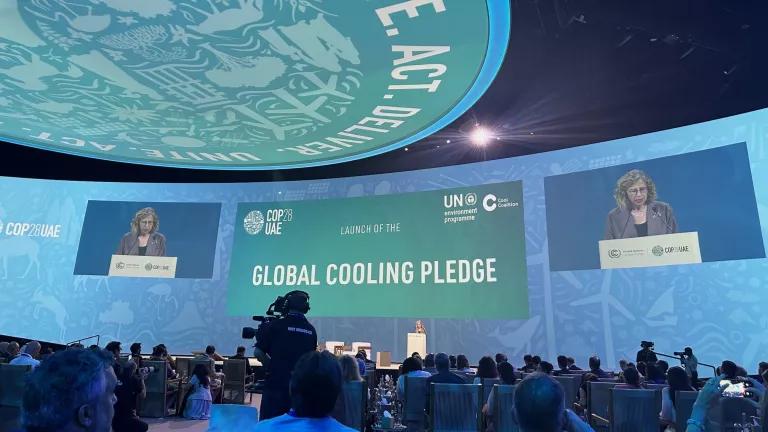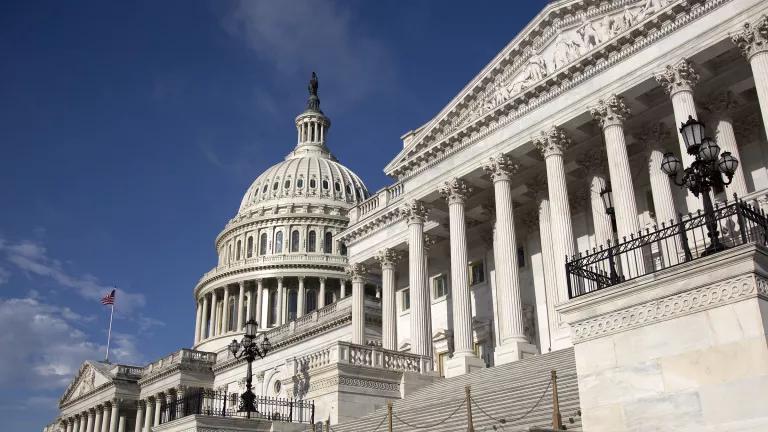HFC Phasedown Marks Top Climate Win of 116th Congress
Year-end omnibus legislation includes a bill to phase down HFC super-pollutants—the biggest action this Congress has taken to meet the climate crisis.

Part of NRDC’s Year-End Series Reviewing 2020 Climate & Clean Energy Developments
Update: On December 27, 2020, tucked into the omnibus end-of-year legislation that became law, was a bill to phase down the use of hydrofluorocarbons, or HFCs, the potent climate-changing gases used in air conditioners, refrigerators, and many other applications that do great damage when released into the atmosphere. The groundbreaking new law, the American Innovation and Manufacturing (AIM) Act, is the biggest action this Congress has taken to meet the climate crisis. The AIM Act is a huge achievement. With its enactment, all the cards are in place for the Biden administration to kick off an ambitious HFC agenda that will lead the country, and the world, beyond these potent climate pollutants.
The AIM Act will cut our production and use of these chemicals by 85 percent over the next 15 years. A Rhodium Group analysis finds that the bill will shrink U.S. annual heat-trapping emissions by the equivalent of around 900 million tons of carbon dioxide over the next 15 years. That’s equal to the yearly emissions of nearly 195 million cars, and (as Rhodium points out) more than the total annual emissions of Germany. The bill is also expected to create 33,000 jobs and spur $12.5 billion of new investments in the U.S. economy. These win-win statistics are a big reason for today’s success story. The bill was championed by dozens of senators and representatives in both parties and backed by a coalition ranging from the Natural Resources Defense Council to the U.S. Chamber of Commerce.
The AIM Act’s passage is a welcome jump-start for the Biden–Harris administration’s ambitious climate plans. The new law will also help restore the United States as a partner and leader in global climate action.
In addition to promising to reenter the Paris Climate Accord on day one, President-Elect Biden has embraced the Kigali agreement, a 2016 amendment to the Montreal Protocol, to phase down HFCs worldwide. Globally, the Kigali Amendment will avoid 70 billion tons of CO2 equivalent by 2050. It will also avoid almost half a degree centigrade of warming by the end of this century. In a world now on track for at least a 3°C temperature rise and searching for ways to hold warming to 1.5 or even 2 degrees, we cannot afford that half degree of warming.
Here are five big steps U.S. Environmental Protection Agency should undertake under the AIM Act as quickly as possible:
1. Phasing down HFC production and import
With AIM’s enactment, EPA needs to issue regulations within 270 days phasing down HFC production and import on a prescribed schedule over the next 15 years. The rules must include “allocations” for each HFC producer and importer to make sure the nation stays under the law’s steadily declining limits.
The AIM Act authorizes EPA to accelerate the HFC phasedown schedule starting in 2025 if, as has happened with predecessor chemicals, technical innovation and market shifts allow faster progress. EPA can use this authority to keep up with—indeed, to push for—swifter action under the Kigali Amendment.
2. Shifting to alternatives in air conditioning and other uses
It’s also time for EPA to establish limits on HFCs in specific end uses where there are already climate-friendlier alternatives. The agency's authority to curb HFC uses was called into question by a 2017 court decision; the AIM Act restores that authority.
Looking ahead, there are immediate opportunities for more ambitious action: This month the California Air Resources Board approved a strong set of HFC regulations that will move large new refrigeration installations away from HFCs starting in 2022 and will transition new air conditioners and heat pumps to alternatives starting in 2025. It will also require that existing refrigeration facilities retrofit their systems by 2030. NRDC looks forward to EPA’s adoption of these standards nationally under the new AIM Act.
3. Stopping HFC leakage
The AIM Act also gives EPA clear authority for leak management regulations that will require safe handling, maintenance, and disposal of HFCs used in industrial and commercial refrigeration and air-conditioning equipment. Such regulations can also promote the reclamation and reuse of existing HFCs—far preferable to leaking them into the air and producing new supplies. Biden’s EPA can be ambitious here with strong leak prevention standards. The prize is big: The HFCs in existing equipment and appliances in this country are equivalent to about two billion metric tons of carbon dioxide.
As a quick first step, EPA can restore common-sense 2016 HFC leak management standards that Trump’s minions tried to roll back. NRDC and states are suing EPA for revoking those rules earlier this year. Using the clear authority of the AIM Act, EPA should restore those requirements, which can prevent HFC emissions equal to six million tons of carbon dioxide each year.
4. Joining the Kigali Amendment
The Biden EPA and State Department can move quickly on U.S. ratification of the Kigali Amendment to the Montreal Protocol, which the Trump administration ignored. Armed with the AIM Act, the new administration should quickly submit the agreement for advice and consent of the Senate, where it enjoys wide bipartisan support. More than 120 other nations are already parties to Kigali. China and India have started transitioning from HFCs and have signaled that they will ratify Kigali too once the United States moves forward.
5. Navigating AIM’s quirks
The AIM Act has a few quirky provisions born out of legislative compromises. First, a handful of small HFC uses—including medical inhalers, defense sprays, semiconductor manufacturing, mission-critical military uses, and a niche category of insulating foams—get first-in-line access to HFCs for five years. There’s no increase allowed in overall HFC supplies, and since alternatives for each of these uses are available already or soon will be, there won’t be any need to extend their special treatment.
Also, the AIM Act doesn’t directly address destruction of HFC-23, an extremely potent HFC emitted from a handful of chemical plants as a byproduct of manufacturing other gases. HFC-23 destruction is required under the Kigali Amendment. But EPA can use other provisions of the Clean Air Act to regulate those facilities.




